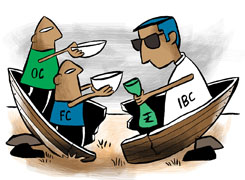Hello sir, I have multiple EMIs and I am doing business. I have 5 EMIs, 1st EMI is 16483 rs and remaining 49,000. 2 EMIs, 2nd is 16800, remaining 14,0000. 3rd EMI is 10100, remaining is 14,0000 and 4th EMI is 4500, remaining 87,000, 5th EMI is 8200, remaining amount is 170000. So total EMIs around 56,0000 principal amount remaining and my monthly income is 80k. Still I have 5,86000 to settle and suddenly I got huge loss in my business and now I am jobless and no any other option of income, so please suggest what should I do and how to come out of debt....please suggest it's a request. Am not able to find any way how to get out of this debt.
Ans: I appreciate that you reached out honestly and took responsibility. Let’s work step by step toward financial stability.
Financial Snapshot at Present
You have total EMIs around Rs.?56,000 per month.
Loan principals remaining total Rs.?5.86?lakhs.
You are currently jobless with monthly income zero.
No immediate alternative income source mentioned.
You are in business and may try restarting.
Your situation is tough. But with a clear plan, you can regain control. Let’s analyse and act.
1. Strict Expense Audit
You must begin with clarity on expenses:
List every monthly expense you have.
Include household, personal, and business costs.
Mark essentials vs non?essentials.
Cut all non?essential spending immediately.
Stop subscriptions, leisure, and luxury outflows.
Redirect savings toward EMI obligations only.
This exercise will free up funds to prioritise debt servicing.
2. Emergency Income Exploration
As you are jobless now, urgent action is essential:
Explore part?time work or freelance gigs.
Offer skills online or offline for income.
Try consulting in your earlier business domain.
Join temporary or gig roles to cover EMIs.
Consider small services like tutoring or delivery until stable.
Any income helps you stay afloat and prevents defaults.
3. Talk to Lenders Proactively
Approach banks and financiers quickly:
Explain your business loss and jobless status.
Request EMI moratorium or interim relief.
Ask for loan repayment rescheduling.
Seek interest-only EMI for some months.
Aim to reduce EMI burden to an affordable level.
Lenders may offer restructuring if approached early.
4. Debt Repayment Strategy: Ladder Method
Once you restore some income:
Prioritise smallest loan for full repayment first.
Then move EMI money to the next smallest loan.
Repeat until all small debts are cleared.
This gives psychological momentum and frees up EMI space.
Once smaller loans are cleared, reallocate funds to bigger loans.
This method keeps you motivated and reduces EMI load faster.
5. Asset Monetisation and Liquidation
Consider using existing assets for debt:
Sell non-essential jewellery or things lying idle.
Withdraw small amounts from any savings or liquid funds.
Use funds to prepay smaller EMIs.
Don’t empty deep savings; retain 1–2 months buffer.
This approach shortens debt tenure and interest burden.
6. Avoid High-Cost Borrowings
Now is not the time for risky debt:
Do not take new loans to repay old ones.
Steer clear of credit cards, personal loans at high rates.
Resist tempting small business loans or gold loans.
This prevents falling into a debt spiral.
7. Business Restructuring
If you plan to restart business:
Analyse where losses occurred.
Cut all non?essential business costs.
Focus on small, quick?turnover products.
Build low?cost, high?margin services.
Reinvest profits slowly into growth.
Keep business and personal finances separate.
Your business can support debt repayment if rebuilt wisely.
8. Emergency Fund Re?Establishment
Once you start earning again:
Set aside 1–2 months’ worth of living expenses.
Keep this in liquid form like a savings account.
This buffer prevents future defaults.
Even a small cushion keeps financial stress manageable.
9. Avoid Investment Disruption
Unless necessary, do not break investments now:
Keep long-term mutual funds or debts intact.
Cancelling SIPs may harm long-term wealth creation.
If needed, stop SIPs temporarily but don’t liquidate.
If you have direct plans like ULIPs or endowments,
consult a CFP about surrendering and reinvesting via MFD.
This protects your future financial foundation.
10. Seek Support for Credit Counseling
You don’t have to do this alone:
Look for credit counselling through non-profit agencies.
They may negotiate with lenders on your behalf.
They offer guidance on debt rehabilitation.
A CFP can help you plan and manage cash flow.
Professional assistance often leads to better outcomes.
11. Re?negotiation After Recovery
When income recovers:
Resume previous EMI schedule gradually.
Or consider prepayment to expedite loan clearance.
Check if prepaying requires penalty.
Prioritise smaller loans or higher interest loans first.
Track monthly debt outstanding and revisit budgets.
Regular reviews keep you on the payment track.
12. Rebuild and Protect Going Forward
After debt payoff, build a stronger future:
Reinstate SIPs into diversified mutual funds.
Prefer regular plans under CFP guidance for safety.
Split into equity (for growth) and debt (for stability).
Build emergency fund worth at least 6 months.
Get term and health insurance if not already present.
Track income and expenses monthly for smooth finances.
These steps ensure long-term stability and peace.
13. Long-Term Financial Discipline
To stay on strong footing:
Maintain savings habit even during recovery.
Keep debt within safe limits of future income.
Plan for retirement post-recovery.
Adjust lifestyle to match income growth.
Discipline paves the road to financial freedom.
14. Psychological and Family Support
Debt impact is more than finance:
Be transparent with family about status.
Seek their support for cost-cutting.
Don’t hide or risk relationships.
Talking may ease stress and spark ideas.
Together, you can handle hardship better.
360?Degree Action Plan Summary
Audit all expenses and cut every non?essential cost.
Look immediately for alternative income options.
Talk to lenders for EMI relief or rescheduling.
Use ladder method to repay smaller loans first.
Monetise idle assets to reduce EMI burden.
Avoid taking high-cost new debts.
Rebuild business with low cost and profit focus.
Create a small emergency buffer with regained income.
Retain long-term investments; stop SIPs if needed.
Use credit counselling or CFP guidance.
After recovery, resume EMI schedules or prepayments.
Re?start SIPs in regular mutual funds via CFP.
Secure term and health insurance.
Rebalance finances every quarter.
Stay transparent with your family to ease burdens.
Final Insights
You are facing difficult times, but you still have options and resilience.
Immediate income and lender negotiation are the first steps.
Cutting expenses sharply will save crucial money.
Small asset sales can free funds for EMIs.
Avoid more debts.
Rebuild systematically without losing hope.
Use small income to prove creditors you are serious.
A structured plan will get you out of the crisis.
After crisis, build back savings, investments, and buffers.
You can recover, grow, and succeed again.
This plan gives clarity, purpose, and a way forward.
Best Regards,
K. Ramalingam, MBA, CFP,
Chief Financial Planner,
www.holisticinvestment.in
https://www.youtube.com/@HolisticInvestment





















